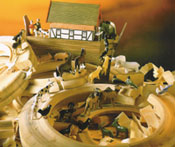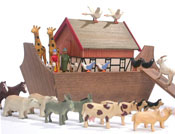About Our Erzgebirge German Folk Art
Folk Art of the ErzgebirgeFor Christmas every year, my wife receives from her parents a piece of seasonal folk art from the Erzgebirge region of Germany. Each piece—whether it's a candelabrum, a nutcracker or a smoking man, a schwibbogen, or a musician for our angel orchestra—quickly has become a part of our holiday traditions, and every member of our family has a favorite that we look forward to rediscovering when Christmas arrives.We are pleased that the Erzgebirge tradition of fine craftsmanship extends beyond the Christmas season, and that the artisans of this area are equally skilled at creating toys and figures such as are found nowhere else in the world. The Erzgebirge and Its TraditionsThe Erzgebirge (literally "Ore Mountain") region lies between Dresden and the Czech border in the former East Germany. It is a beautiful, low mountain range, once densely wooded and rich in metals. Silver was discovered there in the 12th century, and tin two centuries later. Each discovery brought a great influx of settlers to the region, and for hundreds of years it was mining and its relative industries that supported the area's economy.By the 18th century, however, it had become obvious that the supply of ore was dwindling. It is natural that, in seeking to supplement their incomes, the miners and their families looked to the Erzgebirge's other main resource: wood. The abundant forests that had supplied timber for the mineshafts now supplied the materials for Holzhandwerk, or woodworking. Plates, utensils, spindles, and buttons were among the first items to be manufactured, but it was toys that proved most successful. The Erzgebirge region, and especially the town of Seiffen, soon became known as "Toyland" for the crafts that were produced there. But although mining was no longer central to the Erzgebirge's economy, it continued to inform the newer industry. To build and run the mines, some craftsmanship in wood was necessary, and therefore the change in professions was less drastic than one might think. Sources of energy employed in the mines were adapted to power the machines that the woodworkers developed for production. And artistically, the mining life came to be a significant and recurring motif in many of their creations, especially in the Christmas decorations. ReifendrehenThere is perhaps no town more famous for toymaking than Seiffen, the home of many of our manufacturers. As early as 1699 craftsmen from this village were displaying their wares at the Leipzig market. Already the art of turning wood on a lathe was known to them, a method of production that (in a modified form) would come to mark the Seiffen ware as unique. Turning is an economical way to shape wood, both in terms of the amount of wood used and the speed with which it is formed. In Seiffen, the process was further improved upon in the early 19th century with the introduction of Reifendrehen or "ring turning." In this method, the woodworker creates a ring from a section of a tree trunk, and then carves a profile into it. Only when the ring is vertically sliced into sections does the intended form appear. The pieces are then further carved and assembled (if necessary), sanded, painted, and finished by hand, a process that ensures that no two items are alike, though they were cut from the same ring. Turning is an economical way to shape wood, both in terms of the amount of wood used and the speed with which it is formed. In Seiffen, the process was further improved upon in the early 19th century with the introduction of Reifendrehen or "ring turning." In this method, the woodworker creates a ring from a section of a tree trunk, and then carves a profile into it. Only when the ring is vertically sliced into sections does the intended form appear. The pieces are then further carved and assembled (if necessary), sanded, painted, and finished by hand, a process that ensures that no two items are alike, though they were cut from the same ring. Reifendrehen is especially appropriate for making carved wooden animals, especially for the Noah's Ark and other biblical scenes, and may be done on a grand or a miniature scale. While it is an efficient method of production, it is by no means a simple one, requiring enormous skill in figural perception from the designer. Only a few craftsman families in Seiffen continue to employ this method, and we are very proud to offer the work of two of them, Christian Werner and Firma Günter Flath & Sohn. Noah's Ark One of the most popular exports from 19th-century Seiffen was the Noah's Ark and its accompanying animal figures. This carved wooden toy found great favor in England and America, perhaps because its religious subject made it one of the few acceptable toys that might be played with on the Sabbath. Reifendrehen, the Seiffen method of carving wood described above, is particularly suited to produce the figures of animals "going in two by two," and the Noah's Ark sets that we offer (from the workshop of Christian Werner, right) are fine examples of this type of work. One of the most popular exports from 19th-century Seiffen was the Noah's Ark and its accompanying animal figures. This carved wooden toy found great favor in England and America, perhaps because its religious subject made it one of the few acceptable toys that might be played with on the Sabbath. Reifendrehen, the Seiffen method of carving wood described above, is particularly suited to produce the figures of animals "going in two by two," and the Noah's Ark sets that we offer (from the workshop of Christian Werner, right) are fine examples of this type of work. Learn about our Erzgebirge Christmas decorations>> |
|
Don't Miss Anything!
Join our mailing list to learn about news and updates and receive $10 off your order (some restrictions apply).
